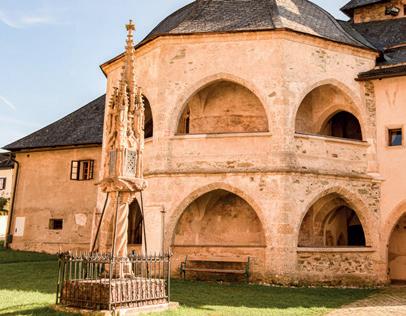
1 minute read
Dom Cathedral
Die Wallfahrts- und Stiftskirche Maria Saal hängt unmittelbar mit der zweiten Christianisierung
Kärntens seit dem 8. Jahrhundert zusammen und gehört mit Karnburg zu den frühesten Kirchengründungen Kärntens. Der vom Bistum Salzburg entsandte Bischof Modestus gründete ein Chorbistum und weihte um 767 eine Marienkirche, “die Kirche der heiligen Maria in Karantanien”. Modestus, auch “Apostel Kärntens” genannt, wurde in der von ihm erbauten Kirche beigesetzt. Noch heute befindet sich sein Grab im Dom. 1116 wurde erstmals die vom Salzburger Erzbischof Konrad in Maria Saal errichtete Propstei urkundlich erwähnt, was die Bedeutung des kirchlichen Standpunktes Marla
Saal erneut unterstrich. Die Kirche in ihrer heutigen spätgotischen Form wurde Anfang bis Mitte des 15. Jahrhunderts mit den umliegenden Klostergebäuden zu einer Wehrkirche ausgebaut, was sich während der Türkeneinfälle 1473 - 1483 bewährte. Nach einem verheerenden Brand 1669 erhielt die Kirche bei der Wiederherstellung ihr heutiges Aussehen. Bei dieser Gelegenheit wurde für den Nordturm die “Maria Saalerin“, Kärntens größte Glocke, gegossen und 1688 geweiht.
The pilgrimage and collegiate church of Maria Saal has been directly connected to the 2nd Christianisation of Carinthia since the 8th century, and together with Karnburg is among the earliest churches to be founded in Carinthia. Bishop Modestus, who was dispatched here by the archdiocese of Salzburg, founded a diocese here, and in around 767 consecrated a church of Saint Mary, “the church of Saint Mary in Karantania”. Modestus, also known as the “apostle of Carinthia”, was buried in the church he had built. His grave is still in the Cathedral to this day. The provost building erected in Maria Saal by the Salzburg Archbishop Konrad was first documented in 1116, which once again emphasised the importance of Maria Saal from the ecclesiastical viewpoint. From the early to mid-15th century, the church in its present-day late-Gothic form was extended to create a fortified church together with the surrounding monastery buildings, and this stood the test during the Turkish invasions between 1473 - 1483. After a disastrous fire in 1669, the church was restored and took on its present appearance. On the occasion of this, the “Maria Saalerin”, the largest bell in Carinthia, was cast for the North Tower, and was consecrated in 1688.
Octagon
Neben der Kirche steht grau und wuchtig der 1416 erstmals erwähnte Karner – um 1500 mit einer neuneckigen, doppelstöckigen Galerie versehen. Diese Friedhofskapelle, in den Anfangszeiten vermutlich auch Taufkapelle, ist im oberen Teil ein Andachtsraum für die Totenmessen. Das Gebäude wird auch Oktogon (Achteck) genannt, obwohl es eigentlich neun Ecken hat.
Alongside the Church stands the massive, grey charnel house, which was first mentioned around 1416, and around 1500 was provided with a nine-sided, two-storey gallery. In its early days, this cemetery chapel was probably also used as a baptistry. The upper section is a prayer room for funeral mass. The building is also known as the Octagon, despite actually having nine sides.







